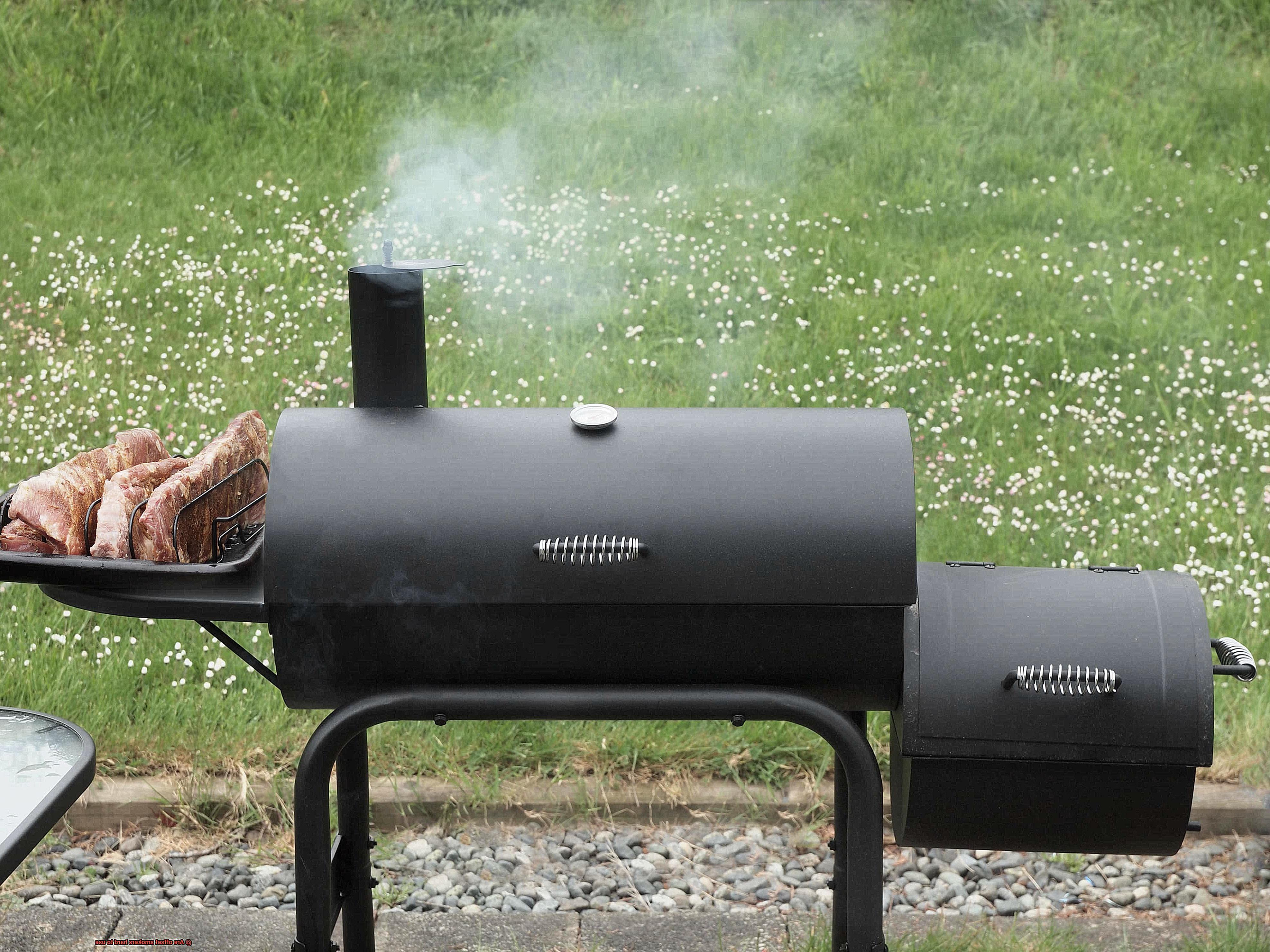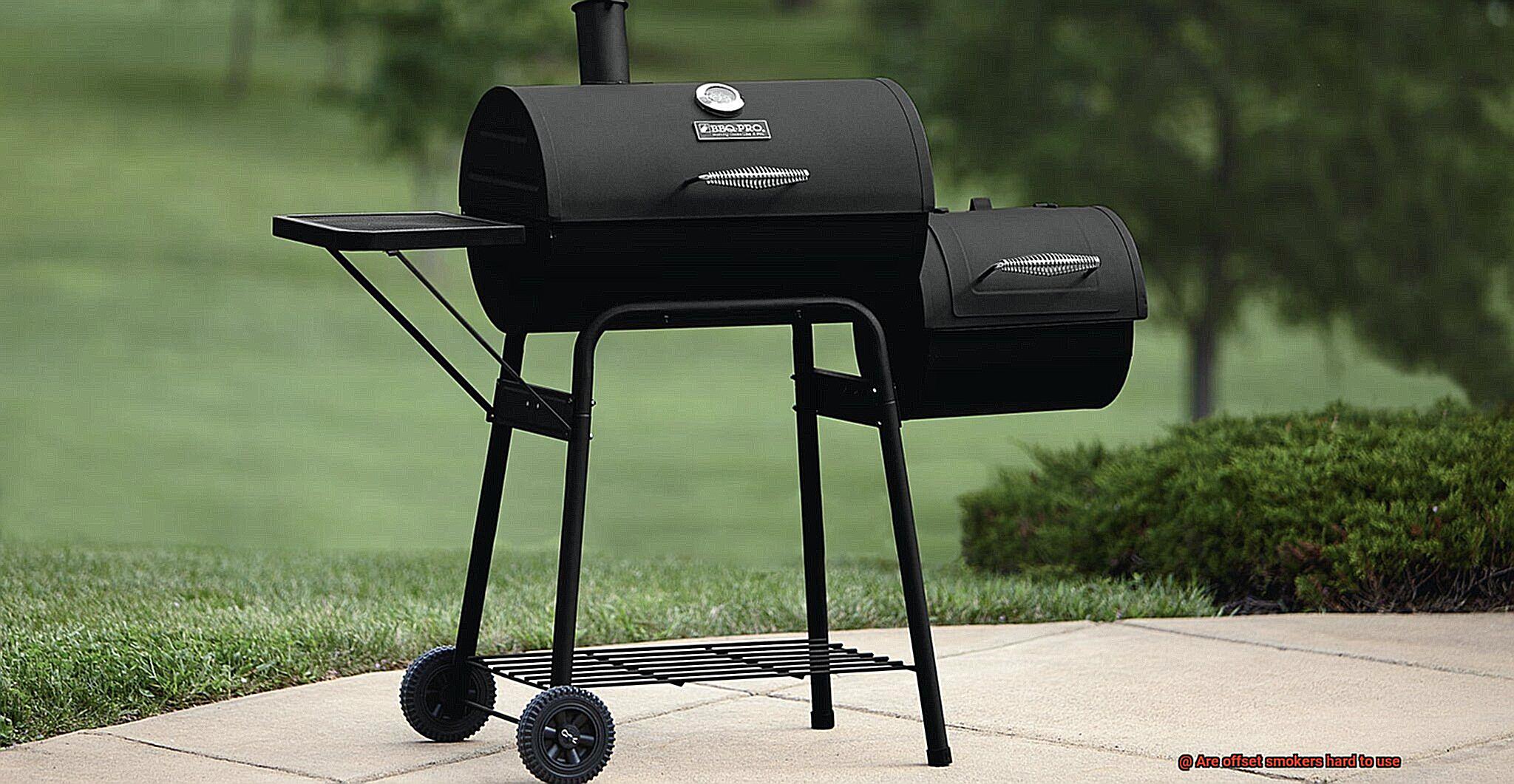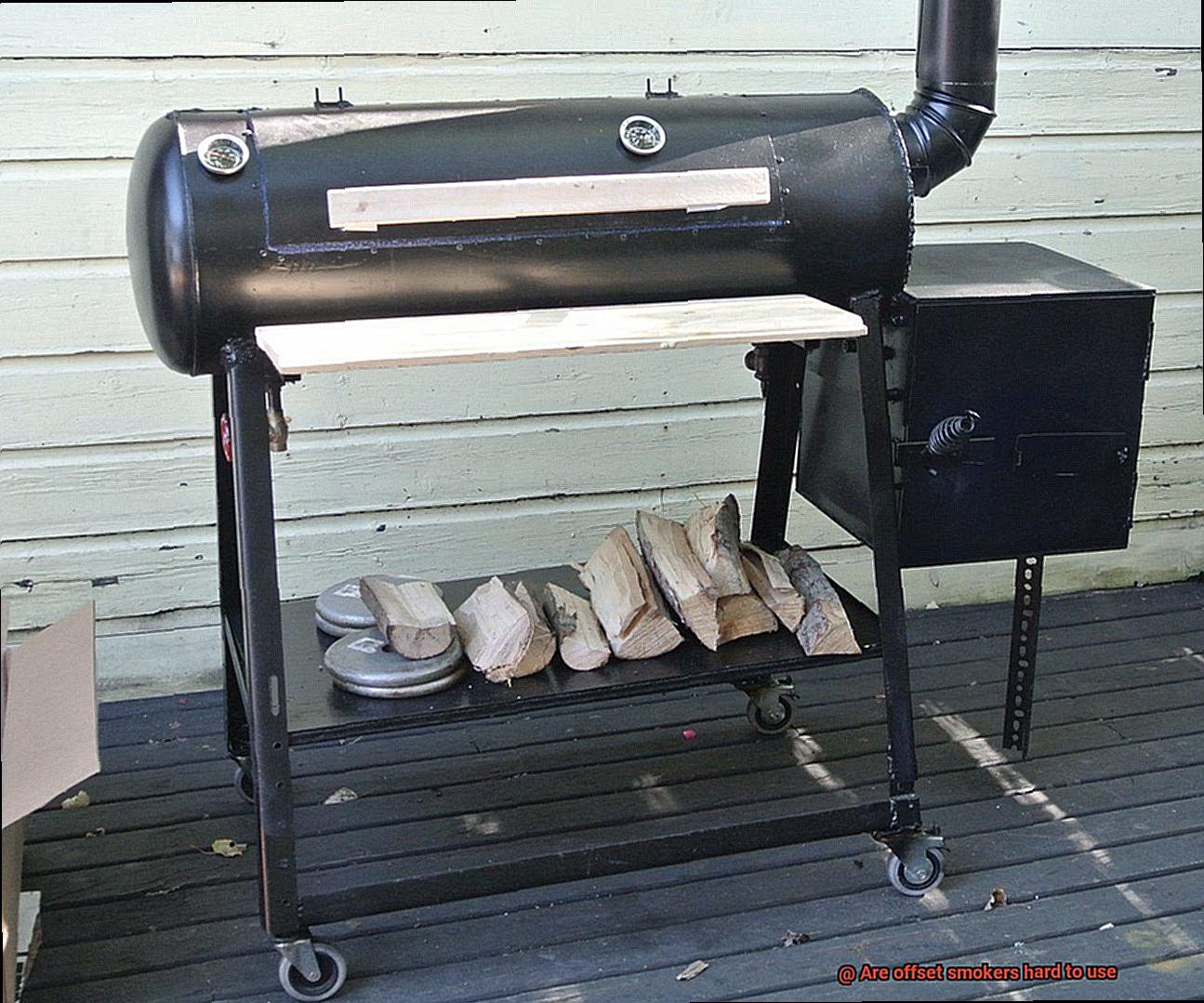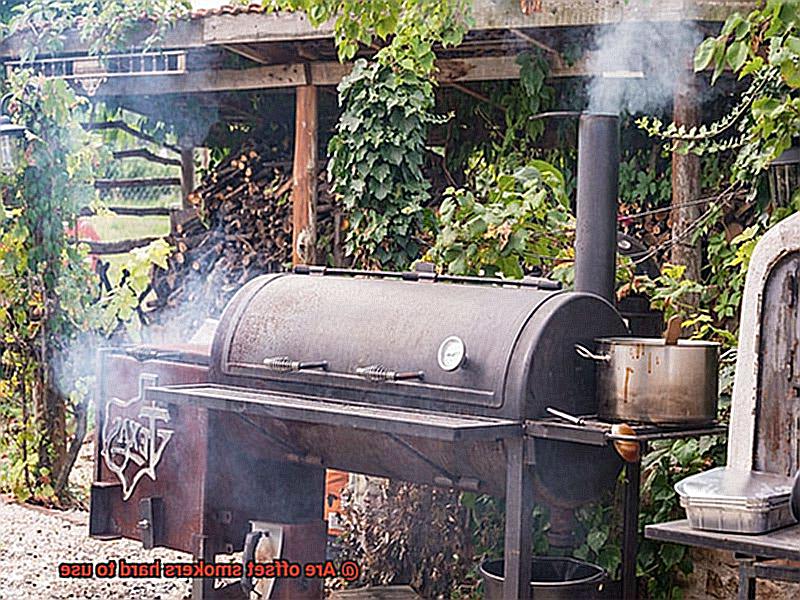Picture this: you’re surrounded by the sweet, smoky aroma of perfectly cooked brisket, ribs, or chicken. It’s a BBQ lover’s paradise. And if you’re like many grill enthusiasts, an offset smoker is the key to achieving that heavenly taste. But for some, the thought of using one can be daunting. So, are offset smokers hard to use? The answer is no – but as with any cooking tool, there are a few things to keep in mind.
One of the biggest advantages of an offset smoker is its ability to maintain a consistent temperature while smoking. This is because the heat source (usually wood or charcoal) is located separately from the cooking chamber. The heat and smoke pass through a small opening between them, allowing your meat to cook slowly and evenly.
But like Spiderman said: “With great power comes great responsibility.” Using an offset smoker does require some skill and attention to detail. Factors such as fuel type and quantity, airflow within the smoker, and weather conditions can all affect temperature and smoke production.
Don’t worry though. With a little practice and some helpful tips, anyone can become an offset smoker pro. In this blog post, we’ll cover all the basics of how to use an offset smoker effectively so that you can wow your friends and family with mouth-watering smoked meats. So get ready to take your BBQ game up a notch.
Contents
Advantages of Using an Offset Smoker
If so, it’s time to consider an offset smoker. Not only does it offer a more authentic style of smoking, but it also provides several advantages that will take your meat smoking game to the next level.
Let’s dive into some of the top advantages of using an offset smoker:
Traditional Style of Smoking
If you’re someone who loves that classic smoky flavor in your meats, then an offset smoker should be on the top of your list. The indirect heat and smoke produced by the smoker impart a traditional taste that can’t be beat.
Large Quantity Cooking
Hosting a big backyard barbecue party or family gathering? No problem. The large cooking chamber of an offset smoker can hold multiple racks of meat at once, allowing you to cook for larger groups of people.
Better Temperature Control
One of the biggest challenges in smoking meat is maintaining a consistent temperature. With an offset smoker, this is no longer an issue. The separate firebox allows for better temperature control, making it easier to achieve that perfect even cook. Plus, you can add wood chips or chunks as needed to enhance the flavor.

Fun and Rewarding Experience
Smoking meat with an offset smoker may seem daunting at first, but the learning curve is part of what makes it such a fun and rewarding experience. It requires patience and practice, but the end result is worth it. Not only will you enjoy delicious smoked meats, but you’ll also have the opportunity to experiment with different wood types and flavor profiles.
Factors that Make Using an Offset Smoker Challenging
This traditional smoking method can produce mouth-watering flavor and cook large quantities of meat, but it comes with its own set of difficulties. As an expert in this topic, let me break down the factors that make using an offset smoker challenging.
First and foremost, constant attention and monitoring are required. Unlike other types of smokers, offset smokers demand a steady supply of wood or charcoal and the temperature needs to be closely monitored to maintain an even heat. This means you can’t just set it and forget it – you need to be vigilant throughout the entire cooking process.
The learning curve involved in mastering the technique is another challenge. Achieving the perfect balance between smoke and heat takes time and practice. Additionally, there are different techniques for loading the fuel and arranging the meat inside the smoker that can affect the final results. You’ll need patience and a willingness to experiment to achieve your desired flavor and texture.

Another challenge is the size of the smoker itself. Offset smokers can be quite large and heavy, making them difficult to move around or store. This can be a problem if you have limited outdoor space or live in an apartment. Make sure you have a suitable location for your smoker before investing in one.
Lastly, weather conditions can also impact the performance of an offset smoker. Wind, rain, and extreme temperatures can affect the temperature inside the smoker, making it challenging to maintain a consistent temperature. Plan ahead for any weather conditions that may arise to ensure your cooking process remains consistent.
Proper Ventilation for an Offset Smoker
Without it, you risk uneven cooking and potentially ruined meat. But fear not, with the right techniques and a little know-how, you can achieve perfectly smoked meat every time.
The key to proper ventilation is keeping the air flowing. To do this, ensure that your smoker has enough vents. Most offset smokers have a damper on the firebox and a chimney on top of the cooking chamber. Adjust these vents accordingly to control the temperature and smoke flow.
When starting your fire, strike a balance between getting enough airflow to get the fire going but not too much that it burns too hot. Open the damper about 75% and adjust it as needed to achieve your desired temperature. The chimney is just as important – opening it wider increases airflow and hotter temperatures, while closing it down decreases airflow and cooler temperatures.
Once you have achieved your desired temperature, maintain it by adjusting the vents as external weather conditions change. Windy days may require adjustments to prevent wind from blowing smoke back into the cooking chamber.
Keep an eye on the smoke coming out of the chimney. Thin, blue smoke is ideal; thick, black smoke means there is not enough airflow and can cause a bitter taste in the meat or harmful chemicals in the smoke. No smoke at all means there is too much airflow and the fire is burning too hot.
In addition to proper vent adjustments, keep your smoker clean. Ash buildup can block airflow and cause uneven cooking. Regularly clean out ash and check for obstructions in the vents.
Quality of the Equipment Matters
It’s well worth investing in a high-quality offset smoker that can meet all your smoking needs and deliver consistent results every time.
The first thing to consider when purchasing an offset smoker is the material it is made of. Steel is the more affordable option, but it’s also prone to rust and corrosion. Cast iron, on the other hand, is more durable and can hold heat better, but it does come at a higher price point. So, depending on your budget and preferences, choose a material that will best suit your needs.
Next up is the design of the smoker. A simple one-chamber smoker can be challenging to control temperature and often leads to uneven cooking. Opting for a multi-chamber smoker with a firebox and cooking chamber will make temperature control much easier and ensure even cooking throughout.
Finally, don’t overlook the importance of accessories and features when it comes to the ease of use of an offset smoker. A good thermometer is essential to monitor temperature accurately. Adjustable vents allow for better control of airflow and temperature regulation, while a good ash pan or tray makes cleaning up after cooking much more manageable.
The Challenge of Maintaining a Consistent Temperature
As any seasoned pitmaster will tell you, maintaining a consistent temperature is the holy grail of smoking meat. And when it comes to offset smokers, it’s a challenge that requires constant attention and adjustment throughout the cooking process.
The reason for this lies in the design of an offset smoker – the firebox is located separately from the cooking chamber, which relies on indirect heat to cook the food. While this allows for more even distribution of heat and a smokier flavor, it also means that regulating airflow and fuel supply is entirely up to the user.
To start, choosing the right type of fuel is crucial in maintaining a steady temperature. Wood or charcoal are the most common choices, each with its own advantages and drawbacks. Wood adds a distinct smokiness to your meat but can be difficult to control, while charcoal burns more evenly but may lack the same depth of flavor.
Once you’ve selected your fuel, it’s time to focus on airflow. The amount of oxygen reaching the fire and how quickly it burns has a direct impact on temperature regulation. To keep things steady, adjust the vents on both the firebox and cooking chamber to create a healthy flow of air that balances out heat and smoke.
But even with careful attention to fuel and airflow, maintaining consistent temperature isn’t always foolproof. That’s where regular temperature monitoring comes in – using a dedicated thermometer or digital probe to check the temperature inside the cooking chamber. This allows you to make adjustments before the temperature gets too high or low, ensuring your meat remains juicy and flavorful.
Tips for Controlling Temperature with an Offset Smoker
Are you a fan of perfectly smoked, juicy meat? If you’re considering using an offset smoker to achieve that perfect flavor, you may be concerned about controlling the temperature. But don’t worry. With some tips and tricks, you can easily maintain a consistent temperature and achieve excellent results with your offset smoker.
Proper Ventilation
One of the most important things to keep in mind when using an offset smoker is proper ventilation. Without enough air flowing through the smoker, it can be difficult to maintain a consistent temperature, or worse yet, risk extinguishing your fire entirely. Make sure to have enough intake vents and exhaust chimneys to ensure adequate airflow.

Placement of Fuel
The placement of your wood or charcoal can significantly impact the temperature inside the smoker. It’s best to place the fuel on one side of the firebox and not directly under the meat. This ensures that heat flows evenly throughout the cooking chamber.
Adjusting Air Vents
Adjusting the air vents is crucial for controlling temperature in an offset smoker. The more air flowing into the smoker, the hotter it will get. If you need to lower the temperature, close down some of the vents. Conversely, if you need to raise the temperature, open up more vents.
Water Pan
Using a water pan inside the smoker can help regulate the temperature and keep your meat moist during cooking. This creates a moist environment that helps prevent your meat from drying out and adds a depth of flavor as well.
Use a Thermometer
Using a good quality thermometer is also essential for controlling temperature in an offset smoker. Place it at grate level, where your meat will be cooking, to get an accurate reading of the temperature inside your smoker.
Practice Makes Perfect
Like any other cooking technique, practice makes perfect when it comes to using an offset smoker. Don’t be discouraged if your first few attempts aren’t perfect. Experiment with different fuel sources, adjust your vents, and monitor your temperature regularly until you find what works best for you and your smoker.
Practice Makes Perfect
Well, the saying “practice makes perfect” certainly holds true here. While it may seem overwhelming at first, with some patience and persistence, anyone can master the art of offset smoking.
One of the biggest challenges with offset smokers is maintaining a consistent temperature throughout the cooking chamber. This can be achieved by experimenting with various fuel types and amounts, and adjusting the dampers to regulate airflow and temperature. It may take some time, but once you discover the right combination, maintaining a consistent temperature becomes much easier.
Managing the smoke is another critical factor in offset smoking. Too much smoke can result in bitter-tasting food, while too little smoke can leave your meat lacking flavor. The key is to experiment with different wood types until you find what suits your taste preferences.
To sum up, using an offset smoker takes practice and effort to master. However, don’t get discouraged if your first attempts aren’t perfect. Keep trying and experimenting until you find what works best for you. Here are some tips to help you along the way:
rHDdem7n1Lo” >
Conclusion
As we come to a close, it’s clear that the answer to the question “Are offset smokers hard to use?” is a resounding no. These smokers offer an unparalleled taste and cooking experience that any BBQ enthusiast would be remiss not to try.
Offset smokers have numerous benefits, including traditional style smoking, better temperature control, large quantity cooking, and a fun and rewarding experience. However, they do require some skill and attention to detail in order to use them effectively.
Some of the challenges of using an offset smoker include constant monitoring, a steep learning curve, size and weight of the smoker, and weather conditions. But fear not. With proper ventilation and quality equipment, these obstacles can be overcome.
The key to mastering an offset smoker lies in maintaining consistent temperature. This can be achieved by selecting the right fuel type and adjusting airflow through the vents. Regular monitoring with a good thermometer is also crucial.
In conclusion, don’t let the challenges deter you from trying out an offset smoker. With patience and persistence in experimenting with different techniques and fuels while keeping an eye on temperature levels, anyone can become an expert in this art.






